Jade Mirror of the Four Unknowns
Jade Mirror of the Four Unknowns,[1] Siyuan yujian (四元玉鉴), also referred to as Jade Mirror of the Four Origins,[2] is a 1303 mathematical monograph by Yuan dynasty mathematician Zhu Shijie.[3] With this masterpiece, Zhu brought Chinese algebra to its highest level.
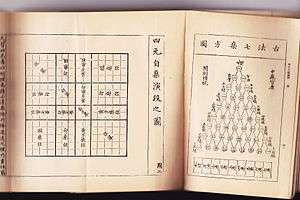
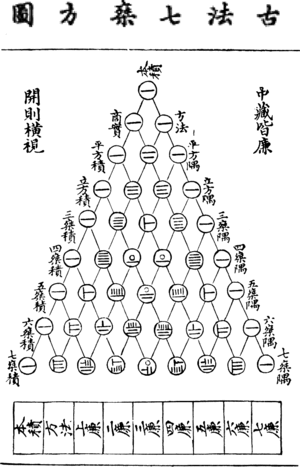
The book consists of an introduction and three books, with a total of 288 problems. The first four problems in the introduction illustrate his method of the four unknowns. He showed how to convert a problem stated verbally into a system of polynomial equations (up to the 14th order), by using up to four unknowns: 天Heaven, 地Earth, 人Man, 物Matter, and then how to reduce the system to a single polynomial equation in one unknown by successive elimination of unknowns. He then solved the high-order equation by Southern Song dynasty mathematician Qin Jiushao's "Ling long kai fang" method published in Shùshū Jiǔzhāng (“Mathematical Treatise in Nine Sections”) in 1247 (more than 570 years before English mathematician William Horner's method using synthetic division). To do this, he makes use of the Pascal triangle, which he labels as the diagram of an ancient method first discovered by Jia Xian before 1050.
Zhu also solved square and cube roots problems by solving quadratic and cubic equations, and added to the understanding of series and progressions, classifying them according to the coefficients of the Pascal triangle. He also showed how to solve systems of linear equations by reducing the matrix of their coefficients to diagonal form. His methods predate Blaise Pascal, William Horner, and modern matrix methods by many centuries. The preface of the book describes how Zhu travelled around China for 20 years as a teacher of mathematics.
Jade Mirror of the Four Unknowns consists of four books, with 24 classes and 288 problems, in which 232 problems deal with Tian yuan shu, 36 problems deal with variable of two variables, 13 problems of three variables, and 7 problems of four variables.
Introduction
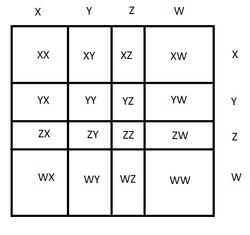
The four quantities are x, y, z, w can be presented with the following diagram

- y




The square of which is:
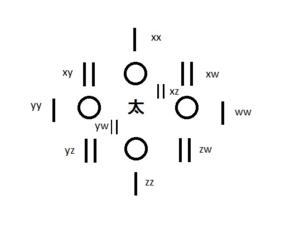
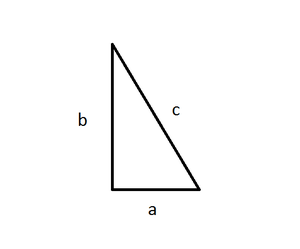
The Unitary Nebuls
This section deals with Tian yuan shu or problems of one unknown.
- Question: Given the product of huangfan and zhi ji equals to 24 paces, and the sum of vertical and hypothenuse equals to 9 paces, what is the value of the base?
- Answer: 3 paces
- Set up unitary tian as the base( that is let the base be the unknown quantity x)
Since the product of huangfang and zhi ji = 24
in which
- huangfan is defined as:[4]
- zhi ji:
- therefore
- Further, the sum of vertical and hypothenus is
- Set up the unknown unitary tian as the vertical
We obtain the following equation








Solve it and obtain x=3
The Mystery of Two Natures











equation: ;
from the given











equation: ;
we get:
- 太


and
- 太



by method of elimination, we obtain a quadratic equation
solution: .
The Evolution of Three Talents
Template for solution of problem of three unknowns
Zhu Shijie explained the method of elimination in detail. His example has been quoted frequently in scientific literature.[5][6][7]
Set up three equations as follows





- .... I
- .....II






- ....III
Elimination of unknown between II and III
by manipulation of exchange of variables
We obtain









- ...IV
and











- .... V
Elimination of unknown between IV and V we obtain a 3rd order equation
Solve to this 3rd order equation to obtain ;
Change back the variables
We obtain the hypothenus =5 paces
Simultaneous of the Four Elements
This section deals with simultaneous equations of four unknowns.
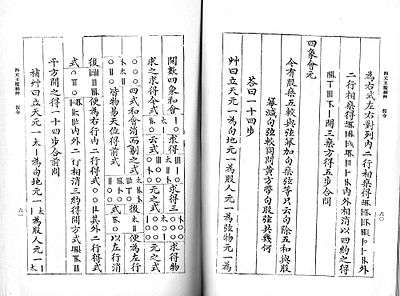
Successive elimination of unknowns to get
Solve this and obtain 14 paces
Book I
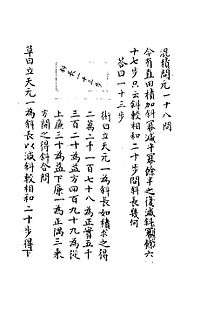
Problems of Right Angle Triangles and Rectangles
There are 18 problems in this section.
Problem 18
Obtain a tenth order polynomial equation:
The root of which is x = 3, multiply by 4, getting 12. That is the final answer.
Problems of Plane Figures
There are 18 problems in this section
Problems of Piece Goods
There are 9 problems in this section
Problems on Grain Storage
There are 6 problems in this section
Problems on Labour
There are 7 problems in this section
Problems of Equations for Fractional Roots
There are 13 problems in this section
Book II
Mixed Problems
Containment of Circles and Squares
Problems on Areas
Surveying with Right Angle Triangles
There are eight problems in this section
- Problem 1
Question: There is a rectangular town of unknown dimension which has one gate on each side. There is a pagoda located at 240 paces from the south gate. A man walking 180 paces from the west gate can see the pagoda, he then walks towards the south-east corner for 240 paces and reaches the pagoda; what is the length and width of the rectangular town? Answer: 120 paces in length and width one li
Let tian yuan unitary as half of the length, we obtain a 4th order equation
solve it and obtain x=240 paces, hence length =2x= 480 paces=1 li and 120paces.
Similarity, let tian yuan unitary(x) equals to half of width
we get the equation:
Solve it to obtain x=180 paces, length =360 paces =one li.
- Problem 7
- Identical to The depth of a ravine (using hence-forward cross-bars) in Haidao Suanjing.
- Problem 8
- Identical to The depth of a transparent pool in Haidao Suanjing.
Hay Stacks
Bundles of Arrows
Land Measurement
Summon Men According to Need
Problem No 5 is the earliest 4th order interpolation formula in the world
men summoned :[10]
In which
- a=1st order difference
- b=2nd order difference
- c=3rd order difference
- d=4th order difference
Book III
Fruit pile
This section contains 20 problems dealing with triangular piles, rectangular piles
Problem 1
Find the sum of triangular pile
and value of the fruit pile is:
Zhu Shijie use Tian yuan shu to solve this problem by letting x=n
and obtained the formular
From given condition , hence
Solve it to obtain .
Therefore,
- 。
Figures within Figure
Simultaneous Equations
Equation of two unknowns
Left and Right
Equation of Three Unknowns
Equation of Four Unknowns
Six problems of four unknowns.
Question 2
Yield a set of equations in four unknowns: .[12]
References
- This title was suggested by Joseph Dauben
- Hart, Roger (2013). Imagined Civilizations China, the West, and Their First Encounter. Baltimore, MD: Johns Hopkins Univ Pr. p. 82. ISBN 1421406063.
- Elman, Benjamin A. (2005). On their own terms science in China, 1550-1900. Cambridge, Mass.: Harvard University Press. p. 252. ISBN 0674036476.
- Zhu Sijie Siyuan yujian Science Press p148 2007 ISBN 978-7-03-020112-6
- Wu Wenjun Mechanization of Mathematics (吴文俊 数学机械化 《朱世杰的一个例子》)pp 18-19 Science Press ISBN 7-03-010764-0
- Zhu Shijie Siyuan yujian, annotated by Li Zhaohua (朱世杰原著 李兆华校正 《四元玉鉴》)p149-153 Science Press 2007 ISBN 978-7-03-020112-6
- J. Hoe Les Systemes d'Equation Polynomes dans le siyuanyujian[1303],Instude Haute Etudes Chinoise, Paris 1977
- 万有文库第二集 朱世杰撰 罗士琳草 (中) 卷下之五 四一0-四一一。
- 万有文库第二集 朱世杰撰 罗士琳草 (中) 卷下之五 四一一页。
- 孔国平 440-441。
- Zhu Shijie Siyuan yujian , with Luo Shilin's procedures. (万有文库第二集 朱世杰撰 罗士琳草 (中) 卷下之一 六四六-六四八)
- Zhu Shijie, Siyuan yujian, annotated by Li Zhaohua , Science Press pp246-249 2007 ISBN 978-7-03-020112-6
Sources
- Jade Mirror of the Four Unknowns, tr. into English by Professor Chen Zhaixin, Former Head of Mathematics Department, Yenching University (in 1925),Translated into modern Chinese by Guo Shuchun, Volume I & II, Library of Chinese Classics, Chinese-English, Liaoning Education Press 2006 ISBN 7-5382-6923-1 https://www.scribd.com/document/357204551/Siyuan-yujian-2, https://www.scribd.com/document/357204728/Siyuan-yujian-1
- Collected Works in the History of Sciences by Li Yan and Qian Baocong, Volume 1 《李俨钱宝琮科学史全集》 第一卷 钱宝琮 《中国算学史 上编》
- Zhu Shijie Siyuan yujian Book 1–4, Annotated by Qin Dyasty mathematician Luo Shilin, Commercial Press
- J. Hoe, Les systèmes d'équations polynômes dans le Siyuan yujian (1303), Institut des Hautes Études Chinoises, Paris, 1977
- J. Hoe, A study of the fourteenth-century manual on polynomial equations "The jade mirror of the four unknowns" by Zhu Shijie, Mingming Bookroom, P.O. Box 29-316, Christchurch, New Zealand, 2007